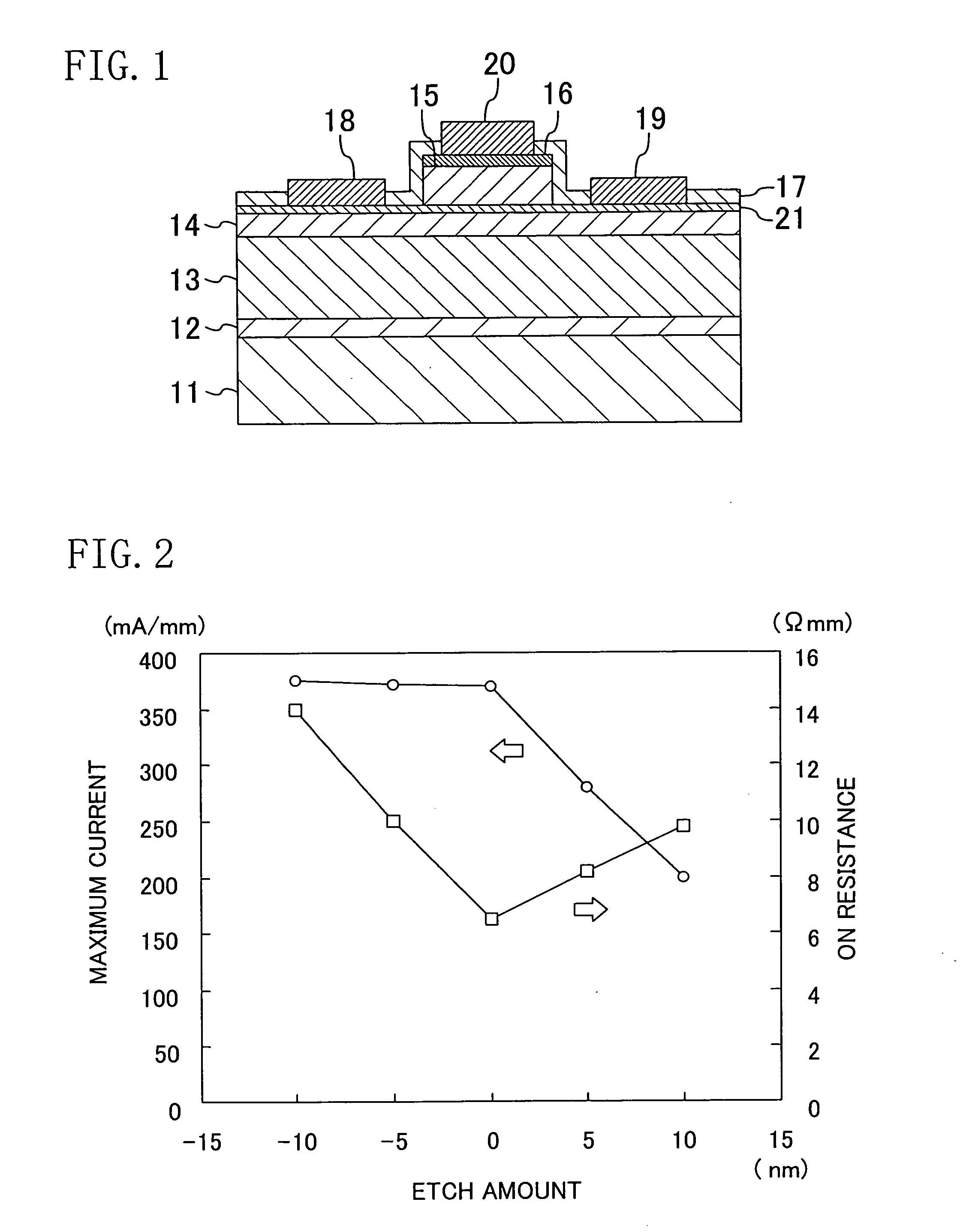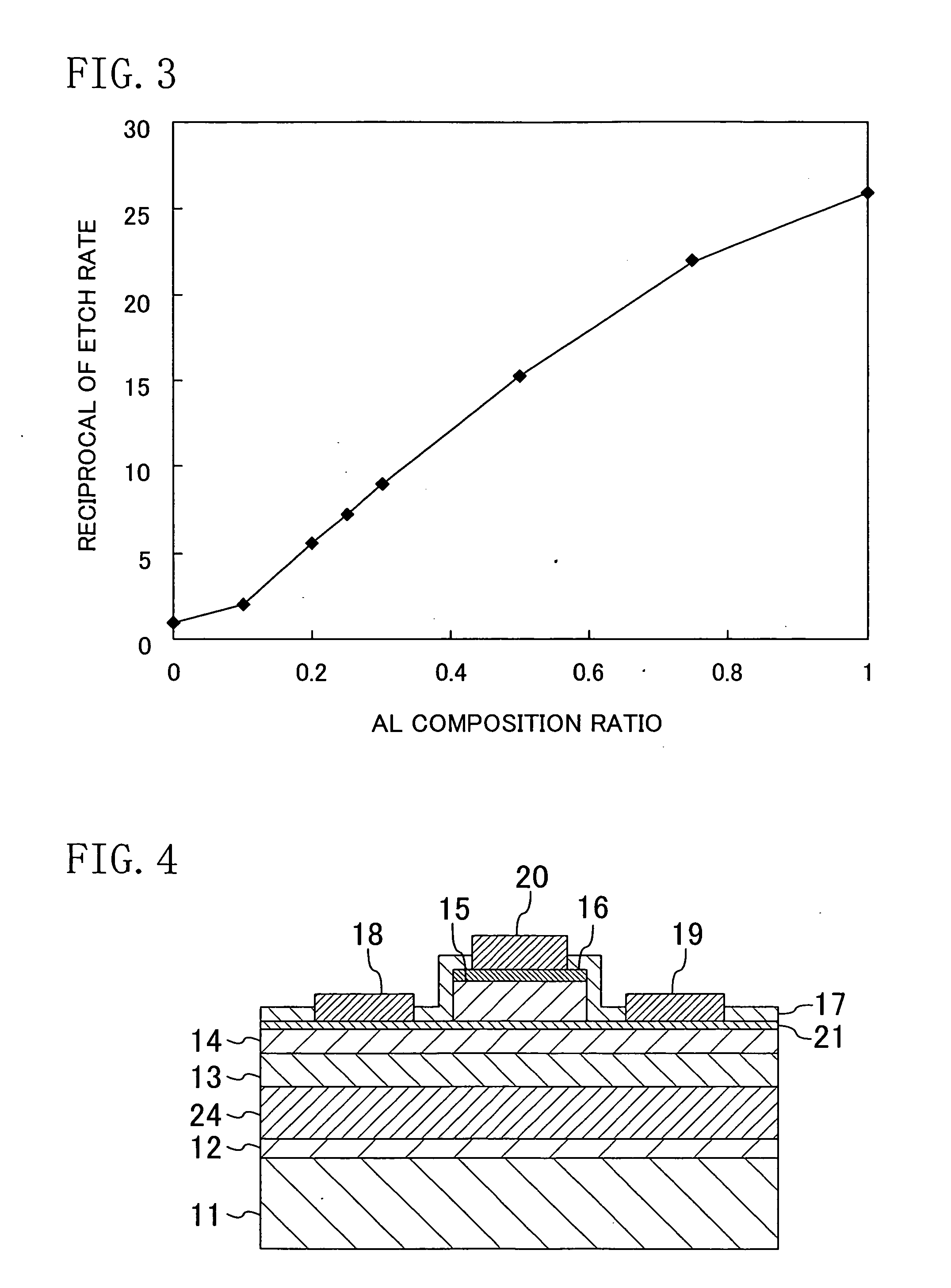Transistor
a transistor and transistor technology, applied in the field of transistors, can solve the problems of deteriorating electrical characteristics, difficulty in obtaining enhancement modes (normally off), and reducing the maximum curren
- Summary
- Abstract
- Description
- Claims
- Application Information
AI Technical Summary
Benefits of technology
Problems solved by technology
Method used
Image
Examples
first embodiment
[0032]Explanation of a first embodiment is provided with reference to the drawings. FIG. 1 shows the sectional structure of a transistor according to the first embodiment. As shown in FIG. 1, the transistor of the present embodiment includes a sapphire substrate 11 having a (0001) plane as a principle surface. On the substrate 11, a 100 nm thick AlN buffer layer 12, a 2 μm thick first semiconductor layer 13 as a channel layer made of undoped GaN, a 25 nm thick second semiconductor layer 14 as a barrier layer made of undoped Al0.2Ga0.8N and a 8 nm thick third semiconductor layer 21 made of undoped Al0.5Ga0.5N are formed in this order.
[0033]On a selected part of the third semiconductor layer 21, a 100 nm thick p-type control layer 15 made of Al0.2Ga0.8N containing p-type impurities is formed. The control layer 15 is doped with magnesium (Mg) at a dose of about 1×1019 cm−3. The carrier concentration in the control layer 15 is about 1×1018 cm−3.
[0034]On the control layer 15, a 5 nm thic...
second embodiment
[0063]Hereinafter, explanation of a second embodiment of the present invention is provided with reference to the drawings. FIG. 6 shows the sectional structure of a transistor according to the second embodiment. As shown in FIG. 6, the transistor of the present embodiment includes a Si substrate 31 having a (111) plane as a principle surface. On the substrate 31, a 40 nm thick AlN buffer layer 32, a 1 μm thick first semiconductor layer 33 made of undoped GaN, a 25 nm thick second semiconductor layer 34 made of undoped Al0.2Ga0.8N and a 8 nm thick third semiconductor layer 41 made of undoped Al0.5Ga0.5N are formed in this order.
[0064]On a selected part of the third semiconductor layer 41, a 100 nm thick control layer 35 made of Al0.2Ga0.8N containing p-type impurities is formed. The control layer 35 is doped with magnesium (Mg) at a dose of about 1×1019 cm−3. The carrier concentration in the control layer 35 is about 1×1018 cm−3.
[0065]On the control layer 35, a 5 nm thick p-type cont...
third embodiment
[0068]Hereinafter, explanation of a third embodiment of the present invention is provided with reference to the drawings. FIG. 7 shows the sectional structure of a transistor according to the third embodiment. As shown in FIG. 7, the transistor of the present embodiment includes a gallium arsenide (GaAs) substrate 51. On the substrate 51, a buffer layer 52 made of a supperlattice including alternately stacked GaAs layers and aluminum gallium arsenide (AlGaAs) layers, a first semiconductor layer 53 made of undoped GaAs, an n-doped Al0.2Ga0.8As layer 54 and a third semiconductor layer 61 made of undoped indium gallium phosphide (InGaP) are formed in this order.
[0069]On a selected part of the third semiconductor layer 61, a control layer 55 made of Al0.2Ga0.8As containing p-type impurities is formed. On the control layer 55, a p-type contact layer 56 made of GaAs containing a larger amount of p-type impurities than the control layer 55 is formed.
[0070]On the p-type contact layer 56, a ...
PUM
 Login to View More
Login to View More Abstract
Description
Claims
Application Information
 Login to View More
Login to View More - R&D
- Intellectual Property
- Life Sciences
- Materials
- Tech Scout
- Unparalleled Data Quality
- Higher Quality Content
- 60% Fewer Hallucinations
Browse by: Latest US Patents, China's latest patents, Technical Efficacy Thesaurus, Application Domain, Technology Topic, Popular Technical Reports.
© 2025 PatSnap. All rights reserved.Legal|Privacy policy|Modern Slavery Act Transparency Statement|Sitemap|About US| Contact US: help@patsnap.com



